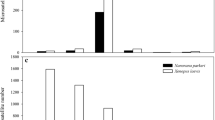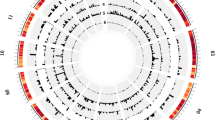Abstract
Microsatellite markers are being used for molecular identification and characterization as well as estimation of evolution patterns due to their highly polymorphic nature. The repeats hold 40% of the entire genome of Orientia tsutsugamushi (OT), but not yet been characterized. Thus, we investigated the genome-wide presence of microsatellites within nine complete genomes of OT and analyzed their distribution pattern, composition, and complexity. The in-silico study revealed that the genome of OT enriched with microsatellites having a total of 126,187 SSRs and 10,374 cSSRs throughout the genome, of which 70% and 30% are represented within the coding and non-coding regions, respectively. The relative density (RD) and relative abundance (RA) of SSRs were 42–44.43/kb and 6.25–6.59/kb, while for cSSRs this value ranged from 7.06 to 8.1/kb and 0.50 to 0.55/kb, respectively. However, RA and RD were weakly correlated with genome size and incidence of microsatellites. The mononucleotide repeats (54.55%) were prevalent over di- (33.22%), tri- (11.88%), tetra- (0.27%), penta- (0.02%), hexanucleotide (0.04%) repeats, with poly (A/T) richness over poly (G/C). The motif composition of cSSRs revealed that maximum cSSRs were made up of two microsatellites having unique duplication patterns such as AT-x-AT and CG-x-CG. To our knowledge, this is the first study of microsatellites in the OT genome, where characterization of such variations in repeat sequences would be important in deciphering the origin, rate of mutation, and role of repeat sequences in the genome. More numbers of microsatellites represented within the coding region provide an insight into the genome plasticity that may interfere with gene regulation to mitigate host–pathogen interaction and evolution of the species.





Similar content being viewed by others
Data availability
The authors confirm that the data supporting the findings of this study are available within the article.
References
Alam CM, Singh AK, Sharfuddin C, Ali S (2013) In-silico analysis of simple and imperfect microsatellites in diverse tobamovirus genomes. Gene 530:193–200
Alam CM, Singh AK, Sharfuddin C, Ali S (2014) Genome-wide scan for analysis of simple and imperfect microsatellites in diverse carlaviruses. Infect Genet Evol 21:287–294
Bagshaw AT, Pitt JP, Gemmell NJ (2008) High frequency of microsatellites in S. cerevisiae meiotic recombination hotspots. BMC Genom 9:49
Basharat Z, Yasmin A (2015) Survey of compound microsatellites in multiple lactobacillus genomes. Can J Microbiol 61:898–902
Batty EM, Chaemchuen S, Blacksell S et al (2018) Long-read whole genome sequencing and comparative analysis of six strains of the human pathogen Orientia Tsutsugamushi. PLoS Negl Trop Dis 12:e0006566
Chen M, Tan Z, Jiang J et al (2009) Similar distribution of simple sequence repeats in diverse completed human immunodeficiency virus type 1genomes. FEBS Lett 583:2959–2963
Chen M, Tan Z, Zeng G, Peng J (2010) Comprehensive analysis of simple sequence repeats in pre-mirnas. Mol Biol Evol 27:2227–2232
Chen M, Zeng G, Tan Z et al (2011) Compound microsatellites in complete escherichia coli genomes. FEBS Lett 585:1072–1076
Chen M, Tan Z, Zeng G, Zeng Z (2012) Differential distribution of compound microsatellites in various human immunodeficiency virus type 1 complete genomes. Infect Genet Evol 12:1452–1457
Du L, Zhang C, Liu Q et al (2017) Krait: an ultrafast tool for genome-wide survey of microsatellites and primer design. Bioinformatics 34:681–683
Fadda Z, Daròs JA, Flores R, Duran-Vila N (2003) Identification in eggplant of a variant of citrus exocortis viroid (cevd) with a 96 nucleotide duplication in the right terminal region of the rod-like secondary structure. Virus Res 97:145–149
Gao Y, Sun S-Q, Guo H-C (2016) Biological function of foot-and-mouth disease virus non-structural proteins and non-coding elements. Virol J 13:1–7
Garrido-Ramos MA (2012) Repetitive DNA. Karger Medical and Scientific Publishers, p 7
George B, Alam CM, Kumar RV et al (2015) Potential linkage between compound microsatellites and recombination in geminiviruses: evidence from comparative analysis. Virology 482:41–50
Haasl RJ, Payseur BA (2010) Multi-locus inference of population structure: a comparison between single nucleotide polymorphisms and microsatellites. Heredity 106:158–171
Houng H-SH, Lott L, Gong H et al (2009) Adenovirus microsatellite reveals dynamics of transmission during a recent epidemic of human adenovirus serotype 14 infection. J Clin Microbiol 47:2243–2248
Jain A, Sharma PC (2021) Occurrence and distribution of compound microsatellites in the genomes of three economically important virus families. Infect Genet Evol 92:104853
Karaoglu H, Lee CM, Meyer W (2004) Survey of simple sequence repeats in completed fungal genomes. Mol Biol Evol 22:639–649
Kashi Y, King D (2006) Simple sequence repeats as advantageous mutators in evolution. Trends Genet 22:253–259
Katti MV, Ranjekar PK, Gupta VS (2001) Differential distribution of simple sequence repeats in eukaryotic genome sequences. Mol Biol Evol 18:1161–1167
Kelly DJ, Fuerst PA, Ching W, Richards AL (2009) Scrub typhus: the geographic distribution of phenotypic and genotypic variants of orientia tsutsugamushi. Clin Infect Dis 48:203–230
Kofler R, Schlotterer C, Luschutzky E, Lelley T (2008) Survey of microsatellite clustering in eight fully sequenced species sheds light on the origin of compound microsatellites. BMC Genom 9:612
Ledenyova ML, Tkachenko GA, Shpak IM (2019) Imperfect and compound microsatellites in the genomes of burkholderia pseudomallei strains. Mol Biol 53:127–137
Liti G, Louis EJ (2005) Yeast evolution and comparative genomics. Annu Rev Microbiol 59:135–153
Mrázek J, Guo X, Shah A (2007) Simple sequence repeats in prokaryotic genomes. Proc Natl Acad Sci 104:8472–8477
Napierala M, Parniewski P, Pluciennik A, Wells RD (2002) Long CTG· CAG repeat sequences markedly stimulate intramolecular recombination. J Biol Chem 277:34087–34100
Nasrin T, Hoque M, Ali S (2023) Microsatellite signature analysis of twenty-one virophage genomes of the family Lavidaviridae. Gene 851:147037
Power PM, Sweetman WA, Gallacher NJ et al (2009) Simple sequence repeats in haemophilus influenzae. Infect Genet Evol 9:216–228
Qi W-H, Lu T, Zheng C-L et al (2020) Distribution patterns of Microsatellites and development of its marker in different genomic regions of forest musk deer genome based on high throughput sequencing. Aging 12:4445–4462
Rathbun MM, Szpara ML (2021) A holistic perspective on herpes simplex virus (HSV) ecology and evolution. Adv Virus Res 110:27–57
Richard G-F, Kerrest A, Dujon B (2008) Comparative genomics and molecular dynamics of DNA repeats in eukaryotes. Microbiol Mol Biol Rev 72:686–727
Sahoo L, Sahu BP, Das SP, Swain SK, Bej D, Patel A et al (2014) Limited genetic differentiation in Labeo rohita (Hamilton 1822) populations as revealed by microsatellite markers. Biochem Syst Ecol 57:427–431
Sahoo L, Patel A, Sahu BP, Mitra S, Meher PK, Mahapatra KD et al (2015) Preliminary genetic linkage map of Indian major carp, Labeo rohita (Hamilton 1822) based on microsatellite markers. J Genet 94:271–277
Sahu BP, Majee P, Singh RR et al (2020) Comparative analysis, distribution, and characterization of microsatellites in ORF virus genome. Sci Rep 10:1–3
Sahu BP, Majee P, Singh RR et al (2022a) Genome-wide identification and characterization of microsatellite markers within the avipoxviruses. 3 Biotech 12:1–7
Sahu BP, George B, Majee P, Singh RR, Mishra A, Tiwari R et al (2022b) A comprehensive analysis of simple sequence repeats in Picorna viruses. Res Sq. https://doi.org/10.21203/rs.3.rs-1557265/v1
Salje J (2017) Orientia tsutsugamushi: a neglected but fascinating obligate intracellular bacterial pathogen. PLoS Pathog 13(12):e1006657
Singh AK, Alam CM, Sharfuddin C, Ali S (2014) Frequency and distribution of simple and compound microsatellites in forty-eight human papillomavirus (HPV) genomes. Infect Genet Evol 24:92–98
Soong L (2018) Dysregulated th1 immune and vascular responses in scrub typhus pathogenesis. J Immunol 200:1233–1240
Sreenu VB, Kumar P, Nagaraju J, Nagarajaram HA (2006) Microsatellite polymorphism across the M. tuberculosis and M. bovis genomes: Implications on genome evolution and plasticity. BMC Genom. https://doi.org/10.1186/1471-2164-7-78
Swain SK, Sahu BP, Das SP, Sahoo L, Das PC, Das P (2022) Population genetic structure of fringe-lipped carp, Labeo fimbriatus from the peninsular rivers of India. 3 Biotech 12:300
Tilak R, Kunte R (2019) Scrub typhus strikes back: are we ready? Medical J Armed Forces India 75:8–17
Tóth G, Gáspári Z, Jurka J (2000) Microsatellites in different eukaryotic genomes: Survey and analysis. Genome Res 10:967–981
Tycowski KT, Guo YE, Lee N et al (2015) Viral noncoding RNAS: more surprises. Genes Dev 29:567–584
Usdin K (2008) The biological effects of simple tandem repeats: lessons from the repeat expansion diseases: Table 1. Genome Res 18:1011–1019
Wang J, Yu X, Zhao K et al (2012) Microsatellite development for an endangered Bream Megalobrama Pellegrini (Teleostei, Cyprinidae) using 454 sequencing. Int J Mol Sci 13:3009–3021
Xu G, Walker DH, Jupiter D et al (2017) A review of the global epidemiology of scrub typhus. PLoS Negl Trop Dis 11(11):e0006062
Acknowledgements
The authors would like to acknowledge the Medical Research Laboratory of the Institute of Medical Sciences and SUM Hospital for providing the laboratory facility. They would also like to thank Siksha ‘O’ Anusandhana (deemed to be) University and SOA University for providing financial support in the form of a Ph.D. fellowship.
Funding
No funding available.
Author information
Authors and Affiliations
Contributions
SP and SKS performed the bioinformatics analysis and wrote the manuscript. SP and SKS created the figures. BPS generated the circos plot. RS designed the study, and BPS executed the study and reviewed the manuscript.
Corresponding author
Ethics declarations
Conflict of interest
The authors declare that they have no conflicts of interest.
Ethical approval and consent to participate
No ethical clearance required.
Consent for publication
Not applicable.
Rights and permissions
Springer Nature or its licensor (e.g. a society or other partner) holds exclusive rights to this article under a publishing agreement with the author(s) or other rightsholder(s); author self-archiving of the accepted manuscript version of this article is solely governed by the terms of such publishing agreement and applicable law.
About this article
Cite this article
Panda, S., Swain, S.K., Sahu, B.P. et al. Insights into genome plasticity and gene regulation in Orientia tsutsugamushi through genome-wide mining of microsatellite markers. 3 Biotech 13, 366 (2023). https://doi.org/10.1007/s13205-023-03795-6
Received:
Accepted:
Published:
DOI: https://doi.org/10.1007/s13205-023-03795-6




